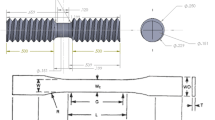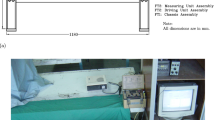Abstract
The literature for creep-to-failure cumulative-damage laws are reviewed. Creep-to-failure tests performed on polycarbonate and polysulfone under single- and two-step loadings are discussed. A semiempirical cumulative-damage rule or modified time-fraction rule is developed, using as the starting point a power law for transient creep response. Experimental results are approximated well by the new rule. Damage and failure mechanisms associated with the two materials are suggested.
Similar content being viewed by others
References
Brinson, H.F., “The Viscoelastic Behavior of a Ductile Polymer,”Deformation and Fracture of High Polymers, ed, H. Kausch et al., Plenum Press, NY, 397–416 (1974).
Brinson, H.F., Renieri, M.P. and Herakovich, C.T., “Rate and Time Dependent Failure of Structural Adhesives,” Frac. Mech. of Comp., ASTM, STP 617, 177–199 (1975).
Brinson, H.F., “Experimental Mechanics Applied to the Accelerated Characterization of Polymer Based Composites,”New Trends in Experimental Mechanics, ed., J.T. Pindera, Springer-Verlag, Vienna, 1–69 (1981).
Brinson, H.F., Griffith, W.J. and Morris, D.H., “Creep Rupture of Polymer-Matrix Composites,” Proc. IV Int. Cong. on Exp. Stress Anal. and Exp. Mech., 329–335 (Sept. 1981).
Brinson, H.F. and Dillard, D.A., “The Prediction of Long Term Viscoelastic Properties of Fiber Reinforced Plastics,” Progress in Science and Engineering of Composites, ed. T. Hayashi et al., 795–802 (1982).
Cartner, J.S., Griffith, W.I. andBrinson, H.F., “The Viscoelastic Behavior of Composite Materials for Automotive Applications,”Composite Materials in the Automotive Industry, ASME, NY, 159–169 (1978).
Robinson, E.L., “Effect of Temperature Variation on the Creep Strength of Steels,” Trans. ASME, 253–259 (1938).
Miller, J., “Effect of Temperature Cycling on the Rupture Strength of Some High Temperature Alloys,” ASTM STP 165, 53 (1954).
Freeman, J.W. and Voorhees, H.R., Literature Survey on Creep Damage in Metals, ASTM STP 391, (1965).
Randall, P.N., “Cumulative Damage in Creep-Rupture Tests of a Carbon Steel,”J. Basic. Eng., Trans. ASME, Series D,84 (2_,239–242 (June 1962).
Goldhoff, R.M. and Woodford, D.H., “Evaluation Creep Damage in a CrMoV Steel,” Testing for Prediction of Material Performance in Structures and Components, ASTM STP 515, 89–106 (1972).
Lieberman, Y., “Relaxation, Tensile Strength and Failure of EI 612 and 20 Khl F-L Steels,”Mettaloved, Term, Obrabotka Metal,4,6–13 (1962).
Oding, I.A. andBurdusky, V.V., “Effect of Variable Stress on the Rupture Strength of Steel,”Issledovaniya Po Sharoprochnim Splavam,6,77–88 (1960).
Johnson, A.E., Henderson, J. and Khan, B., “Complex-Stress Creep, Relaxation and Fracture of Metallic Alloys,” Her Majesty's Stationary Office, Edinburgh, 22–32 (1962).
Voorhees, H.R. and Freeman, J.W., “Notch Sensitivity of Aircraft Structural and Engine Alloys,” Wright Air Dev. Ctr. Tech. Rep., Part II, Further Studies with A-286 Alloy, 23 (Jan. 1959).
Abo El Ata, M.M. andFinnie, I., “A Study of Creep Damage Rules,”J. Basic Eng.,94,R533 (1972).
Bui-Quoc, T., “An Engineering Approach for Cumulative Damage in Metals Under Creep Loading,”J. Eng. Mat. and Tech.,101,337–343 (Oct. 1979).
Kargin, V.A. andSlonimskii, G.L., “Mechanical Properties (of Polymers),”Encyclopedia of Polymer Science Technology,8,445–516 (1968).
Lemaitre, J. and Chaboche, J.L., “A Nonlinear Model of Creep-Fatigue Damage Accumulation and Interaction,” Mechanics of Visco-Elastic Media and Body, ed. J.A.H. Hult, IUTAM Symp., Gothenburg, Sweden (Sept. 1974).
Findley, W.N. andLai, J.S.Y., “A Modified Superposition Principle Applied to Creep of Nonlinear Viscoelastic Material Under Abrupt Changes in State of Combined Stress,”Trans. Soc. Rheology,11 (3),361 (1967).
Schapery, R.A., “On the Characterization of Non-Linear Viscoelastic Materials,”Polymer Eng. and Sci.,9, (4),295–310 (1969).
Hiel, C., Cardon, A.H. and Brinson, H.F., “The Nonlinear Viscoelastic Response of Resin Matrix Composite Laminates,” VPI & SU Rep., VPI-E-83-6 (March 1983).
Dillard, D.A., Morris, D.H. and Brinson, H.F., “Creep and Creep Rupture of Laminated Graphite/Epoxy Laminates,” VPI & SU Rep., VPI-E-81-3 (March 1984).
Findley, W.N., Lai, J.S. andOnaran, K., Creep and Relaxation of Nonlinear Viscoelastic Materials, North Holland, NY (1976).
Brueller, O.S., “Stress-Relaxation Crazing of Polymers—An Energy Criterion,”Polymer Eng. and Sci.,23 (15),844–848 (Oct. 1983).
Sato, Y., “Crazing of Amorphous Polymers- III. Temperature Stress Dependence of Crazing Polycarbonates,”Kobunshi Kagaku,23,69–77 (1966).
Wang, T.T., Matsuo, M. andKwei, T.K., “Criteria of Craze Initiation in Glassy Polymers,”J. Appl. Phys.,42 (11),4188–4196 (Oct. 1971).
Zhang, M.J. and Brinson, H.F., “The Nonlinear Viscoelastic Response of Polycarbonate and Polysulfone” (in preparation).
Ross, B., ed. “Fractional Calculus and its Applications Springer-Verlag, NY (1925).
Bagley, R.L. and Torvik, P.J., “Fractional Calculus in the Transient Analysis of Viscoelastically Damped Structures,” AIAA Struct. and Mat. Conf., Reno, NV, 314–324 (May 1983).
Author information
Authors and Affiliations
Additional information
performed this work Visiting Scientist, Department of Engineering Science and Mechanics, Virginia Polytechnic Institute and State University.
Rights and permissions
About this article
Cite this article
Zhang, M.J., Brinson, H.F. Cumulative creep damage for polycarbonate and polysulfone. Experimental Mechanics 26, 155–162 (1986). https://doi.org/10.1007/BF02320009
Received:
Revised:
Issue Date:
DOI: https://doi.org/10.1007/BF02320009




